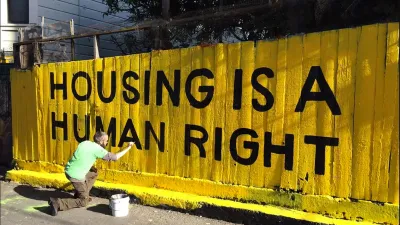The geography of talent is changing. Richard Florida takes a closer look at where the creative class is moving as a result of the housing affordability crisis in many of the largest and most famous cities in the country.

Richard Florida maps the "rise of the rest" that is taking shape in cities outside of superstar cities all over the country, the "result of both increasingly unaffordable housing in established hubs and the improvement of the economies in less-established hubs."
According Florida's analysis of the term he made famous, the "creative class" is spreading around the country. The article illustrates the trend with a series of maps and infographics. Florida worked with Todd Gabe, an economist at the University of Maine, to track the growth of the creative class overall and across U.S. metros from 2005 to 2017, using data from the U.S. Census American Community Survey (ACS).
In the years that passed from that period, the creative class grew substantially in leading cities, and the rankings of cities with the largest share also changed substantially. In 2017, San Jose has the largest share of creative class, followed by D.C. and San Francisco, explains Florida.
Between 2005 and 2017, Denver and Philadelphia joined the top ten, but a lot of other stories of growth can be told. "A number of Rustbelt and Sunbelt metros which have previously lagged now show robust growth," according to Florida. "Salt Lake City posted the fastest growth, with Pittsburgh and Cincinnati next in line. Las Vegas, which had the smallest creative class share of large metros in 2005, also saw significant growth."
The article also lists the cities where growth of the creative class was slowest over that period.
FULL STORY: Maps Reveal Where the Creative Class Is Growing

Alabama: Trump Terminates Settlements for Black Communities Harmed By Raw Sewage
Trump deemed the landmark civil rights agreement “illegal DEI and environmental justice policy.”

Planetizen Federal Action Tracker
A weekly monitor of how Trump’s orders and actions are impacting planners and planning in America.

The 120 Year Old Tiny Home Villages That Sheltered San Francisco’s Earthquake Refugees
More than a century ago, San Francisco mobilized to house thousands of residents displaced by the 1906 earthquake. Could their strategy offer a model for the present?

In Both Crashes and Crime, Public Transportation is Far Safer than Driving
Contrary to popular assumptions, public transportation has far lower crash and crime rates than automobile travel. For safer communities, improve and encourage transit travel.

Report: Zoning Reforms Should Complement Nashville’s Ambitious Transit Plan
Without reform, restrictive zoning codes will limit the impact of the city’s planned transit expansion and could exclude some of the residents who depend on transit the most.

Judge Orders Release of Frozen IRA, IIJA Funding
The decision is a victory for environmental groups who charged that freezing funds for critical infrastructure and disaster response programs caused “real and irreparable harm” to communities.
Urban Design for Planners 1: Software Tools
This six-course series explores essential urban design concepts using open source software and equips planners with the tools they need to participate fully in the urban design process.
Planning for Universal Design
Learn the tools for implementing Universal Design in planning regulations.
Clanton & Associates, Inc.
Jessamine County Fiscal Court
Institute for Housing and Urban Development Studies (IHS)
City of Grandview
Harvard GSD Executive Education
Toledo-Lucas County Plan Commissions
Salt Lake City
NYU Wagner Graduate School of Public Service





























